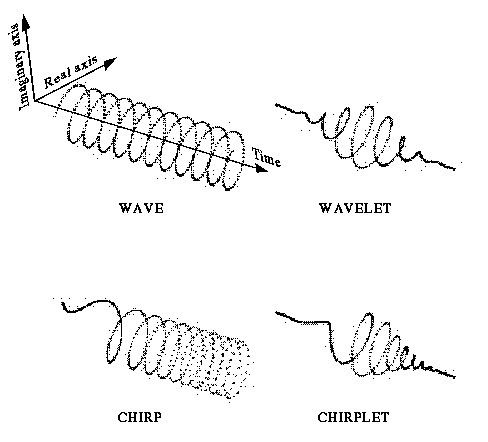 | ||
In signal processing, the chirplet transform is an inner product of an input signal with a family of analysis primitives called chirplets.
Contents
Similar to the wavelet transform, chirplets are usually generated from (or can be expressed as being from) a single mother chirplet (analogous to the so-called mother wavelet of wavelet theory).
Definitions
The term chirplet transform was coined by Steve Mann, as the title of the first published paper on chirplets. The term chirplet itself (apart from chirplet transform) was also used by Steve Mann, Domingo Mihovilovic, and Ronald Bracewell to describe a windowed portion of a chirp function. In Mann's words:
A wavelet is a piece of a wave, and a chirplet, similarly, is a piece of a chirp. More precisely, a chirplet is a windowed portion of a chirp function, where the window provides some time localization property. In terms of time–frequency space, chirplets exist as rotated, sheared, or other structures that move from the traditional parallelism with the time and frequency axes that are typical for waves (Fourier and short-time Fourier transforms) or wavelets.
The chirplet transform thus represents a rotated, sheared, or otherwise transformed tiling of the time–frequency plane. Although chirp signals have been known for many years in radar, pulse compression, and the like, the first published reference to the chirplet transform described specific signal representations based on families of functions related to one another by time–varying frequency modulation or frequency varying time modulation, in addition to time and frequency shifting, and scale changes. In that paper, the Gaussian chirplet transform was presented as one such example, together with a successful application to ice fragment detection in radar (improving target detection results over previous approaches). The term chirplet (but not the term chirplet transform) was also proposed for a similar transform, apparently independently, by Mihovilovic and Bracewell later that same year.
Applications
The chirplet transform is a useful signal analysis and representation framework that has been used to excise chirp-like interference in spread spectrum communications, in EEG processing, and Chirplet Time Domain Reflectometry.
The Warblet transform
The warblet transform is a particular example of the chirplet transform introduced by Mann and Haykin in 1992 and now widely used. It provides a signal representation based on cyclically varying frequency modulated signals (warbling signals).
